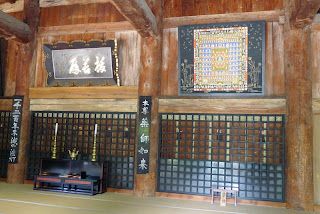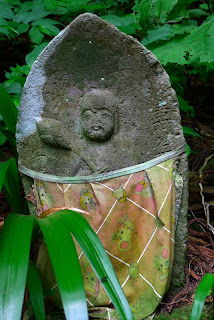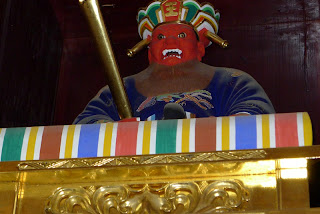Monday, 23 July 2012
Yamadera Mountain Temple Day
I have felt excited about today's journey up Yamadera Mountain since we arrived here in Tendo City, even without knowing what to expect! The morning was sunny and already very warm, above 30 degrees, so when the front desk clerk at the lovely Azumaso Ryokan offered to drive us to the JR Station when we mentioned where we were going, I was happy to accept!
Because we arrived in Tendo along the same train route, and we had had a glimpse of Yamadera Mountain then, it was just a matter of retracing our steps to get back to Yamadera, on two local trains. When we arrived, it was still early in the day, so we had plenty of time to have a leisurely and prayer-filled walk up the Mountain. The JR Station is located very close to the base of the Mountain, so it was a few minutes' walk through tiny Yamadera town, filled with tourist shops featuring local crafts and Temple souvenirs, to get to the entranceway steps, the first one hundred of the eleven hundred steps that lead through the old-growth trees, rocky stone outcroppings, monuments, temples and shrines to the top of the Mountain.
Yamadera was founded more than eleven hundred years ago in 860, the early part of the Heian period, as a temple of the Tendai Buddhist sect, under its official name of Rissyakuji. Its popular name, Yamadera, literally means "mountain temple" in Japanese. To found the Temple, the Kyoto Emperor Seiwa sent one of his most important Buddhist priests, Jikaku Daishi, to what was then the country's frontier region, in the Yamagata area of Tohoku (Northern Honshu). Daishi, who was responsible for the founding of many of Japan's most important Buddhist temples, has a sculpture honoring him at the base of the mountain.
Also located around the base of the mountain are several temple buildings, including Konponchudo Hall, Yamadera's main hall, which is constructed entirely of beech wood, a rare building material. This building is the temple's oldest and stores Buddhist statues and a flame that has been burning since Yamadera's foundation. The flame had been brought from Enryakuji Temple in Kyoto, the head temple of the Tendai sect, to which Yamadera belongs. We are keeping a spiritual journey book that has recorded our visits to Chusonji and Motsuji, and at Konponchudo Hall, we asked a monk to inscribe our visit here as well.
All along the thousand plus steps of Yamadera are ancient halls, shrines and sculptures dedicated to the Amita Buddha, or Amitabha, lanterns,and monuments, some carved into the many stone boulders that line the route. The effect is breathtaking.
Through his efforts, Amitābha created the "Pure Land," which is situated in the far west, beyond the bounds of our own world. By the power of his vows, Amitābha has made it possible for all who call upon him to be reborn into this Pure Land, to be taught the dharma by him, and ultimately to become bodhisattvas and buddhas in their turn. These same bodhisattvas and buddhas then return to our world to help yet more people.
Amitabha is the Buddha of comprehensive love, whose most important enlightenment technique is the visualization of the surrounding world as a paradise. Whoever sees his world as a paradise, awakens his enlightenment energy. The world can be seen as a paradise by a corresponding positive thought, or by sending light to all beings (wishing all beings to be happy).
Yamadera, in the far north and west of old Japan, has metaphorically the same location as the paradise of the Pure Land, located in the farthest west, beyond the bounds of our world. And walking up to the top of this temple complex truly felt like walking through a paradise of the natural beauty of rocks, trees and flowers, combined with deepest spirituality and the man made beauty of shrines of painstakingly crafted wood, copper roofs, and stone steps.
Many of the monuments along the way up the Mountain are dedicated by families to their children who died early in life. At one of these shrines, we met a Japanese couple who explained that the figures we were looking at helped ease the passage of souls from this life to the next, by taking off their worldly clothes, and giving them instead pure temple robes to wear.
Yamadera is also known for a visit by the famous poet Basho, who composed one of his most enduring haiku there. During Basho's journey into northern Japan in the late 1600s he stopped at Yamadera and composed a haiku about the stillness and silence of this area. We saw a statue of Basho and a rock inscription of this famous haiku in the lower area of the temple grounds, but the museum dedicated to him across the hillside from the JR Station was closed on the day we were there.
This was a day of feeling the stillness and beauty of Yamadera Temple Complex, one of the most moving experiences on our trip so far.
Subscribe to:
Post Comments (Atom)




































































































































































No comments:
Post a Comment